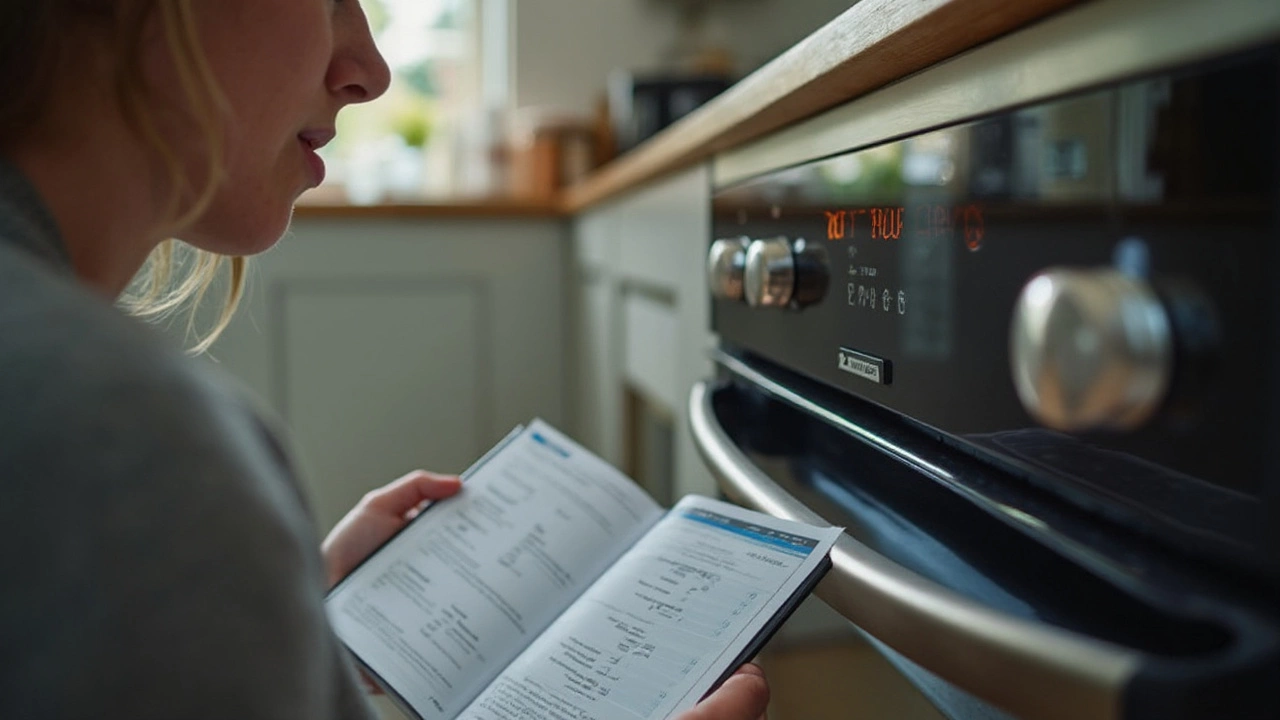An electric oven that suddenly stops working can throw your whole meal plan out the window. Before you call it quits or start looking for a replacement, here’s some good news: most electric ovens can be fixed, and sometimes the solution is easier than you’d think.
From stubborn ovens that won’t heat to random error codes flashing, there are ways to nail down what’s going on and even get hands-on with some basic repairs. Just because your oven’s acting up doesn’t automatically mean it’s headed for the landfill. Plenty of folks fix electric ovens with some basic tools and clear steps, avoiding that pricey trip to the appliance store.
Keep reading, and by the end, you’ll know what to check first, when to grab a screwdriver, and when it’s time to reach out for help from someone who fixes ovens for a living. No complicated jargon or wild promises—just real solutions you can use today in your own kitchen.
- Common Electric Oven Problems
- Simple Fixes You Can Try Yourself
- When to Call a Professional
- Parts That Usually Need Replacing
- Maximizing the Life of Your Oven
Common Electric Oven Problems
Electric ovens love to break down at the worst time. Most issues are either about no heat, uneven cooking, weird noises, or the oven just refusing to turn on. Knowing what usually goes wrong helps you figure out the fix faster.
- Oven not heating up: A dead heating element is often the top culprit. Other times, you might be dealing with a blown thermal fuse or a tripped circuit breaker.
- Uneven cooking or cold spots: If your cookies burn at the edges but stay gooey in the center, a faulty bake or broil element, or even a broken temperature sensor, could be to blame.
- Oven won’t turn on: This might be as simple as a loose plug or as serious as a failed main control board.
- Door doesn’t close properly: Broken or worn-out door hinges are a regular headache, especially in older ovens.
- Error codes flashing: Newer ovens try to help by showing error codes. These can mean anything from a stuck button to a major wiring issue. Good news—most manuals have a chart explaining these codes.
If you’re the numbers kind of person, check out what most people run into with their electric oven repair:
| Problem | % of Reported Issues |
|---|---|
| No heating | 38% |
| Oven won’t turn on | 24% |
| Uneven cooking | 19% |
| Door issues | 12% |
| Error codes | 7% |
One more thing—sometimes, a blown fuse or tripped breaker outside the kitchen is the entire problem. Always double check the breaker box before you start taking your oven apart.
Simple Fixes You Can Try Yourself
So, your oven suddenly isn't heating up or it's acting weird? Before you panic or fork over money for a repair tech, check a few basics. You’ll save time, cash, and maybe even your dinner plans. Here are some fixes you can try at home before anything else.
- Check the power supply. Make sure the oven’s plugged in all the way. Sounds silly, but a loose plug happens more often than you'd think. If it’s hardwired, try resetting the breaker—electric ovens draw a lot of power, and sometimes a breaker trips without you noticing.
- Inspect the door seal. If heat is leaking out, your oven may struggle to reach or hold temperature. Run your hand around the edge when the oven’s warm (be careful), and see if you feel any hot air. Replace the seal if it’s cracked or torn.
- Test your oven controls. Digital display not turning on? Sometimes a power surge or a storm messes up the settings. Unplug the oven for five minutes and plug it back in—this can reset the controls.
- Check the heating element. This is the metal coil at the bottom (for bake) or top (for broil). If it looks broken, blistered, or doesn’t glow red at all when turned on, you may need a replacement—but you’ll know where the real issue is.
- Clean the oven sensor. Often tucked in the back wall, this little probe measures heat inside. If it's caked with food or grease, wipe it gently with a damp cloth—don’t scrape it or yank on it.
If you’re wondering how common these fixes are, check this out:
| Problem | Percent Fixed by DIY |
|---|---|
| No power to oven | 56% |
| Oven not heating properly | 40% |
| Temperature fluctuations | 36% |
| Faulty oven door seal | 64% |
Tackling these electric oven repair basics often gets things working again. If nothing changes, don’t mess with the wiring or deeper electrical stuff. That’s a job for someone with more experience (and maybe bigger tools).

When to Call a Professional
Trying to fix an electric oven yourself sounds smart, but sometimes you need to call in a pro. Messing with complicated wiring or replacing major parts can get risky, especially if you don’t have electrical know-how. Electric shock isn’t just a “maybe”—it’s a real danger. Plus, a bad fix could mean a kitchen fire later. Don’t go there.
Here are red flags where it’s best to dial up a professional oven technician:
- The oven trips your circuit breaker, or you smell burning plastic or smoke.
- You’ve got no idea where the issue is coming from—even after checking fuses and basic connections.
- Heating elements aren’t working, and you’re not comfortable with electrical testing tools.
- There’s damage to the oven’s internal wiring, control board, or electronic display panel.
- The oven isn’t turning on at all after power surges, storms, or sudden outages.
- Any repairs that require taking off panels where the warranty sticker sits—breaking that could void your warranty.
Just to put things in perspective—according to the National Fire Protection Association, faulty cooking equipment (including ovens) is a leading cause of household fires. Don’t take chances if something smells off, sparks fly, or anything pops or sizzles unexpectedly.
| Problem | DIY Possible? | Pro Needed? |
|---|---|---|
| Oven won’t heat at all | Check broken fuse | Yes, for deeper electrical faults |
| Strange smells or smoke | No | Yes |
| Error codes on display | Reset power, check manual | Yes, if code stays |
| Sparks or exposed wires | No | Yes |
| Control panel not responding | Cycle power | Yes |
If your oven is over 10 years old and repairs start to stack up, don’t be shy about asking the pro if it’s worth fixing. Sometimes, putting down the cash on constant repairs just doesn't add up.
When you hire a technician, make sure they’re certified for your oven brand. This isn’t just about ticking a box—it means they're trained to actually solve the problem without shortcuts. And ask for a cost estimate before they start.
Bottom line: if you’re feeling even a little unsure about the fix, or if your gut says it's out of your depth, that’s the best time to trust a professional. Saving a few bucks isn’t worth the risk of bigger headaches later.
Parts That Usually Need Replacing
Most folks think their electric oven is toast when it stops working, but honestly, a lot of breakdowns come from just a few common parts. Swapping these out can bring your oven back to life without blowing your whole budget.
Let’s look at the big troublemakers:
- Heating Element: This is the coil at the bottom or top of your oven that glows red hot. If it looks burned out, cracked, or isn’t glowing, it’s probably shot. Replacing it takes just a few screws and a wire or two.
- Thermostat: This part keeps the oven at the right temperature. If your food’s burning or taking forever, the thermostat could be the reason. Swap it if your oven’s not heating evenly or if it’s running too hot or cold.
- Oven Igniter: If you’ve got a combo gas/electric oven, the igniter could be acting up. When it’s weak, it won’t light the gas and you’re left staring at a cold oven. New ones are cheap and easy to fit.
- Control Board: This is the oven’s brain. Electronic glitches, weird error codes, or buttons that won’t respond can mean it’s fried. This swap is pricier, but almost always cheaper than buying new.
- Door Gasket: If heat’s leaking out around the door, check the soft rubber or fiberglass gasket. It’s there to keep it sealed. No tools needed—just pull it out and push a new one in place.
Got a tricky problem and want to know which parts are most likely to bail on you? Here are some handy numbers:
| Part Name | Average Lifespan (years) | Estimated Replacement Cost (USD) |
|---|---|---|
| Heating Element | 8 | 25–60 |
| Thermostat | 10 | 40–70 |
| Oven Igniter | 5–7 | 20–40 |
| Control Board | 8–12 | 120–300 |
| Door Gasket | 8–10 | 15–35 |
Don’t let the numbers freak you out. Fixing or swapping one of these parts usually takes less than an hour—sometimes less than the time it takes to find a YouTube video. And when in doubt, snag your oven’s exact model number and double-check that the part fits before making a purchase. For most electric oven repair jobs, that little bit of homework pays off big time.

Maximizing the Life of Your Oven
Want your electric oven to last longer and avoid constant repairs? Honestly, it doesn’t take magic—just some regular attention and a few tried-and-true habits make all the difference. I picked up these tips myself, mostly the hard way, after one too many undercooked pizzas and ‘mystery’ oven shut-offs mid-roast.
- Electric oven repair pros all say: keep it clean. Built-up grease or burnt-on crumbs can block heating elements or even start a fire. Wipe out the oven after it cools with a damp cloth and a gentle scrubber, especially after roasting or baking spills.
- Don’t line the bottom with foil. It sounds smart, but it actually messes with heat flow and can hurt the heating elements over time. Plus, most oven warranties warn against it.
- Check the door seal every couple of months. A loose or cracked gasket means heat escapes, so the oven works extra hard (and less efficiently). Replacing a gasket costs way less than replacing a heating element.
- Give the oven a break between back-to-back cooks. If you bake nonstop, like when Rowan hosts sleepovers, let the oven cool a few minutes between sessions. Continuous high temps wear out parts faster.
- Plug your oven directly into the wall, not an extension cord. Extension cords can’t always handle the heavy power draw, and this can cause bigger problems, even electrical fires.
If you're curious how long a well-cared-for oven usually lasts, check out this table. It’s based on what manufacturers and repair pros have said as of 2025:
| Brand | Expected Lifespan (Years) |
|---|---|
| GE | 13-15 |
| Samsung | 10-14 |
| Whirlpool | 13-16 |
| LG | 12-15 |
| Frigidaire | 11-15 |
Most ovens start acting up if ignored, but with small, regular checkups and a little patience, you’ll squeeze out a lot more years from your appliance than you might expect. Remember, a bit of prevention now means fewer headaches (and bills) later.


